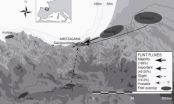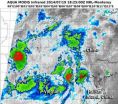(Press-News.org) This news release is available in Spanish.
Never before had the mobility patterns and management of lithic resources in the Upper Palaeolithic been determined so precisely. The study of flint remains found in the open-air Ametzagaina site in Donostia-San Sebastian has determined the economic territory of the human groups that lived there for about 2,000 years. The paper, Where to and What for? Mobility Patterns and the Management of Lithic Resources by Gravettian Hunter-Gatherers in the Western Pyrenees, has been published in the Journal of Anthropological Research.
The first inhabitants of Donostia-San Sebastian lived about 25,000 years ago in the spot known today as the Ametzagaina park. Cro-Magnons of the Upper Palaeolithic set up their camps there for a couple of millennia, as shown by the remains in the open-air site. Sites of this type are much more difficult to locate than those found in caves and, what is more, "in theory they are not a good basis for drawing conclusions as they tend to provide little more than the remains of lithic industry," explained Álvaro Arrizabalaga. On this site, the oldest in the Donostia-San Sebastian area, however, a significant set of flint items were found. Despite the fact that the area has changed a lot, this find was made possible by the fact that the lines of attack and defence of Donostia-San Sebastian during the Carlist Wars [1833-1876] were located in this area, and there were parts of the site that had been buried and protected under the earth banks beside the trenches. Numerous flint tools were found while taking samples under these banks. The rock is endowed with excellent properties for carving, an art mastered by those human groups. In fact, in the Gravettian culture to which the Cro-Magnons of Ametzagaina belonged, clear technological progression took place in this sphere.
These groups were nomads: they had no permanent settlements, but temporary camps instead and basically moved around a territory indefinitely. "Determining where they obtained the flint makes it possible to establish their economic territory. The cultural territory, that of art, is much broader, it would cover the whole of Western Europe," explained the Arts Faculty lecturer. "Flint was their steel, but it was not abundant, they had to know the locations where there were seams, they made their way there, they rough-hewed it on the spot and returned to their camps just with whatever they could make use of," he added.
The researchers also compared the remains in this site with those in other nearby sites; they found that outcrops of peninsular flint were worked in 90% of the sites in the Peninsular Basque Country, and that outcrops of the Continental Basque Country were worked in 90% of the sites in the Northern Basque Country. In other words, the exploitation area tended to be radial and cover about 100 km2. But this is not the case in Ametzagaina. "They exploited the outcrops on both sides of the Pyrenees, their territory was shaped like a sandglass because it gets thinner across the Bidasoa pass," pointed out the researcher. In fact, flint from Chalosse, in the south of Les Landes, was found on the site; it was used to make arrowheads and spears, because the mineral obtained there was of exceptional quality and large format; and they also found flint from Kurtzia on the Biscay coast to the north of Bilbao, and from the Urbasa ridge, in the northwest of Navarre, in addition to what they obtained at the nearby Donostia-San Sebastian site of Gaintxurizketa. But, as Arrizabalaga pointed out, "it was more than their flint territory, it was the area where they hunted, gathered and fished. It was their economic territory."
INFORMATION:
Bibliographical reference:
WHERE TO AND WHAT FOR? Mobility Patterns and the Management of Lithic Resources by Gravettian Hunter-Gatherers in the Western Pyrenees. Alvaro Arrizabalaga, Aitor Calvo, Irantzu Elorrieta, Jesús Tapia, Andoni Tarriño. Journal of Anthropological Research, vol. 70, 2014. http://dx.doi.org/10.3998/jar.0521004.0070.204
The economic territory of Upper Palaeolithic groups is specified by flint
2014-07-21
ELSE PRESS RELEASES FROM THIS DATE:
Cost of World Cup may be too high for Brazil
2014-07-21
Brazil's World Cup has been estimated to be the priciest of any yet, with a projected cost of $11.5 billion. Some predictions even claim that the Brazilian government will have spent up to $14 billion on building and renovating 12 stadiums; upgrading federal, state and city infrastructure; and ensuring security.
In a country with many economic and social issues that need to be addressed, such amounts of spending—more than three times the amount spent on the last World Cup—seem irresponsible to Brazilian citizens who are eager to understand the benefits of such spending, ...
Filter bed substrates, plant types recommended for rain gardens
2014-07-21
RALEIGH, NC – Urban stormwater runoff is causing problems for the world's water sources. In the United States, the Environmental Protection Agency found stormwater runoff to be one of the top 10 causes of compromised environments in rivers, streams, lakes, ponds, reservoirs, bays, and estuaries. The pollutants from urban stormwater runoff can harm fish and wildlife populations, foul drinking water, and make recreational areas unsafe.
Researchers from North Carolina State University are looking to rain gardens as one way to remediate the water quality concerns caused by ...
Organic apple orchards benefit from green compost applications
2014-07-21
FAYETTEVILLE, AR – In traditional apple orchards, effective management practices rely on two interrelated components: finding ways to manage competitive vegetation under the trees, and supplying important supplemental nutrition to trees. These factors are further complicated in organic management systems where limited tools are available, and producers need to meet the stringent soil fertility and crop nutrient management standards of the National Organic Program. University of Arkansas scientists published a study that includes recommendations for the use of various groundcover ...
LEDs shine in bedding plant production study
2014-07-21
WEST LAFAYETTE, IN – Growers of annual bedding plant seedlings or plugs work to produce compact, fully rooted transplants with a large stem diameter and high root dry mass--qualities that make seedlings less susceptible to damage during shipping and transplant. To achieve these desirable qualities, greenhouse growers in northern latitudes must rely on supplemental lighting from high-pressure sodium lamps during winter months. A new study shows that light-emitting diodes (LEDs) can give greenhouse growers other lighting options that produce favorable results.
Previously, ...
Typhoon Rammasun made final landfall near China and Vietnam border
2014-07-21
Typhoon Rammasun made landfall in southern China on July 19 bringing heavy rain and typhoon-strength winds to the south China/Vietnam border. NASA and NOAA's Suomi NPP satellite captured an infrared image the typhoon that showed strong thunderstorms with heavy rain potential.
Rammasun made landfall in southern China just north of the Vietnam border on July 18 at 8 p.m. EDT (July 19 at 0000 UTC). The Joint Typhoon Warning Center placed Rammasun's center near 21.9 north and 108.1 east, about 134 nautical miles (154.2 miles/248.2 km) east-northeast of Hanoi, Vietnam. Maximum ...
New research from Africa on pharmacomicrobiomics
2014-07-21
New Rochelle, NY -- The Human Microbiome Project (HMP) is a global initiative to identify and characterize the microorganisms present at multiple sites in the human body. An international team of researchers reports on new ways to harness the results of the HMP and discusses how changes in the microbiome might affect human health, disease, immunity, and importantly, the safety and effectiveness of drug treatment in a Review article that is part of the special issue "OMICS in Africa: Moving 21st Century Integrative Biology from Lab to Village to Innovation Ecosystems," of ...
Fires in Indonesia, July 2014
2014-07-21
Terra and Aqua satellites detected 154 hotspots in areas across Riau province on Sunday, July 20, indicating forest and land fires had increased again following a decline in rainfall. The number of detected hotspots in Sunday's report was far higher than what had been reported one day prior, which had reached only 75 spots.
The hotspots were scattered in six regencies and municipalities, most of which were in northern Riau coastal areas. Smoke and the related haze it creates could potentially spread via winds to Malaysia and Singapore as it seems to be doing in this ...
Tropical Storm Wali no more, but remnants soaked Hawaii
2014-07-21
On July 19, NOAA's Central Pacific Hurricane Center noted that Wali didn't even make it to the Big Island, but moisture associated with the storm did. NOAA's GOES-West satellite captured an image of the remnant low southwest of the Big Island, and a moisture stream that extended over it.
That remnant moisture was enough to cause the local National Weather Service office to issue an early morning flash flood watch on July 19. An infrared image from NOAA's GOES-West satellite showed the moisture stream as a diagonal line of clouds extending from what was the center of the ...
Parents want info about circumcision, not directives from health-care providers
2014-07-21
ANN ARBOR, Mich. – Most parents expect healthcare providers to answer their questions about circumcision, but they don't want a specific recommendation on the procedure, according to a new University of Michigan C.S. Mott Children's Hospital National Poll on Children's Health.
More than half of male infants born in the United States are circumcised, but the rates of circumcision continue to decline.
"Both pro- and anti-circumcision advocates feel strongly about their views, which can create anxiety for new or expectant parents who are trying to find objective information ...
Another advancement in imaging from INRS professor François Légaré's team
2014-07-21
François Légaré's team at the INRS Énergie Matériaux Télécommunications Research Centre successfully imaged a chemical reaction with a spatial and temporal resolution greatly exceeding that obtained to date using microscopes. The team used a femtosecond laser source to shoot a molecular movie of how an acetylene molecule turns into vinylidene. An article presenting the advancement was recently published in the scientific journal Nature Communications.
"The approach we developed combines multiphoton ionization and Coulomb explosion imaging. With the significantly improved ...





